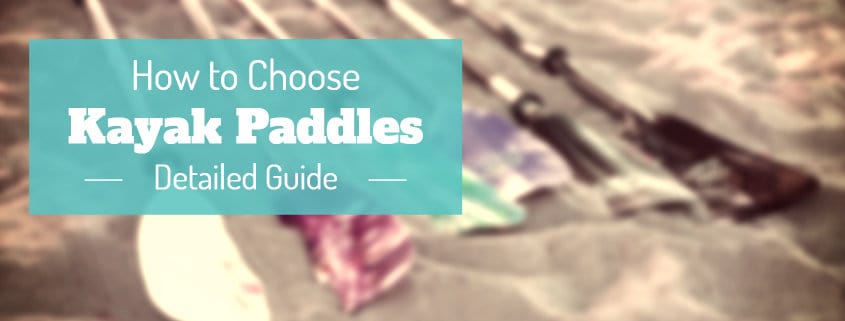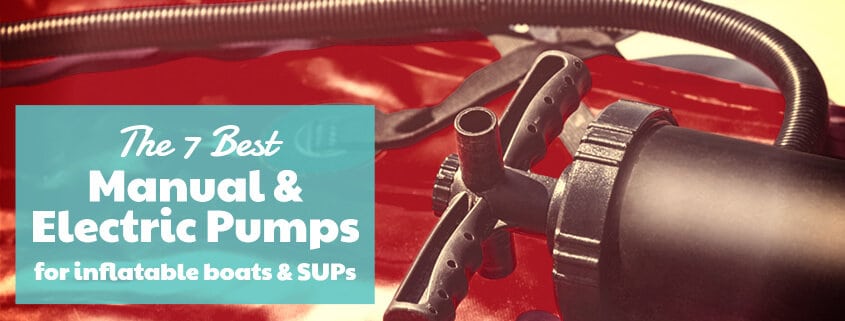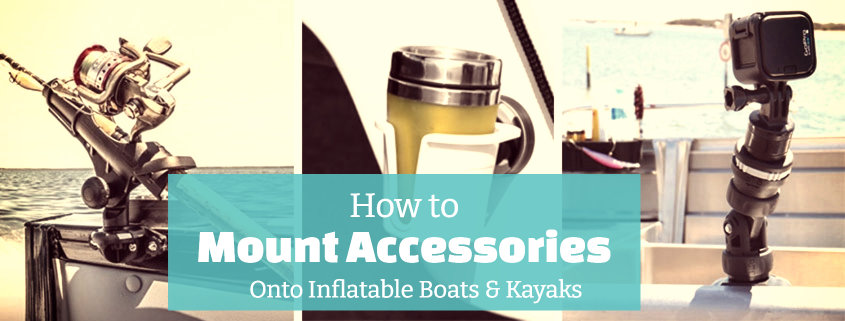The paddle used for inflatable kayaks is not necessarily identical to the ones that go with traditional hard-shell kayaks. Mostly, inflatable kayaks are wider than standard kayaks. This increased width needs to be accounted for when shopping for a paddle, along with your height and the kind of paddling you would be typically resorting to.
Let’s discuss how to choose a kayak paddle in a bit more detail.
There are a few things to consider when choosing a paddle for a kayak, be it inflatable or hard-shell.
Contents
How to choose kayak Paddle Length?
An inflatable kayak’s paddle length usually falls in the 220 to 240 cm range. There are multiple factors to consider when deciding what size paddle you need for your inflatable kayal:
- your height
- your kayak’s width
- your paddling style and angle
Let’s go through each factor.
Paddler Height
The height of the paddle correlates to your height. Generally,
- If you are between 5’0″ (1.52 m) and 5’6″ (1.68 m), a 220 cm long paddle should be ideal.
- For people who are anywhere between 5’2″ (1.57 m) and 6’2″ (1.88 m), 230 cm is the length to look for.
- If you are more than 5’6″ (1.68 m) tall, your inflatable kayak paddle should be at least 240 cm.
The right paddle is not just about how long it is in relation to your height. Your kayaking style matters too. It’s basically a matter of choice and personal preference. For instance, some kayakers may fancy a 240 cm long paddle despite being less than 5’6″ (ca. 168 cm) tall.
The paddle length that suits most people is 230 cm. People who are 5’8″ tall could be fine with a 230 cm long paddle in most scenarios. However, when they hop on to a wider kayak, like an inflatable kayak, a 240 cm paddle feels a lot more natural. Kayakers who are more than 5’6″ tall would invariably find a 220 cm paddle a bit too short and awkward to handle.
Kayak Width
As aforementioned, the inflatable kayak’s width must be considered when choosing a paddle. There is no standard width for an inflatable kayak. It could usually be anywhere from 28 inches (ca. 71 cm) to 40 inches (ca. 1 meter). Not surprisingly, you would need a longer paddle for the wider kayaks to enjoy convenient low-angle paddling.
Generally, inflatable kayaks that have a width of 32 inches (81 cm) and below go well with either a 230 cm or 220 cm paddle. If you are 6′ tall or above, then a 240 cm long paddle would be ideal. For inflatable kayaks with a 33′ width or more, a 240 cm or 230 cm paddle would be perfect, even if you have short stature. The extra paddle length comes in handy with the additional width of the kayak. Else, you could end up scraping your kayak’s sides and overreaching.
| Kayak width | |||||
|---|---|---|---|---|---|
| > 23" | 23" - 28" | 28" - 32" | 32" < | ||
| Your height | > 5' | 210 cm | 220 cm | 230 cm | 240 cm |
| 5' - 5'6" | 210 cm | 220 cm | 230 cm | 240 cm | |
| 5'6" - 6' | 220 cm | 220 cm | 230 cm | 250 cm | |
| 6' < | 220 cm | 230 cm | 240 cm | 250 cm | |
How Paddling Style Affects a Paddle
Generally, longer paddles are ideal for relaxed strokes, longer distances, and slower cadence. Shorter paddles are invariably suited for a faster cadence and more aggressive stroking.
Shorter paddles also help with quick maneuvering and control. They, therefore, are ideal for white water kayaking. For flat, open water paddling, longer paddles are recommended.
Paddling Angle – Low vs High Angle?
When paddling a kayak, you can use low angle paddling or high angle paddling. What is the difference between them?
- Low-angle paddling entails a more relaxed, slower stroke. The blade is a lot more parallel with the water. Low-angle strokes are great for relaxed, longer kayaking trips.
- High-angle paddling, on the other hand, suits a faster, more aggressive paddling style. It usually is the stroke of choice in white water kayaking where the ability to maneuver and quickly speed up is important. Such a paddling style entails increased effort and should also help you lose some weight in the process.
Here is a video that will help you understand the difference between low and high angle paddling, so you can decide on what kind of kayak paddles you need:
Your paddling angle (low or high) would not necessarily determine your paddle’s size. However, longer paddles help with efficient low-angle stroking and shorter paddles generally make their presence felt during a high-angle stroke. Irrespective, you should still factor in your kayak’s width and your height.
Paddle Blade Design
Another key consideration when purchasing a paddle for your inflatable kayak is the design of the blade.
The design of the blade affects its surface area and how it directs water. This is achieved by modifying the shape, length, width and curvature of the paddle blade.
Symmetric vs asymmetric blade shape – Symmetric blades can move more water if used properly. Because of this, they are the choice kayakers who prefer high stroke paddling, and of whitewater paddlers. Low-paddling is harder with symmetric blades.
Asymmetric blades are used by kayakers who prefer a leisurely low-angle stroke. When the asymmetric blade enters the water at a low angle, the special asymmetric shape allows for both halves of the blade to have the same contact area with the water.
Flat vs dihedral blade curvature – A flat blade is flat across the surface, with the possible exception of a rib down the center. This rib helps guide the flow of water across the surface of the blade to minimize flutter.
Dihedral blades have a spine or curvature down the center of the blade. This guides the water flow across the surface of the blade, reducing flutter. Water is directed along the face to the outer edge of the blade, allowing for even strokes with less flutter than a flat blade.
Narrow vs wide blades – Needless to say, the blade’s width would determine the level of “bite” you draw from the water. Wider paddles would take a larger bite. In other words, they would be more acceleration-friendly and will enable quick sharp turns. Narrower blades move a lot quicker through the water, without as much effort. This makes them ideal for long-distance kayaking.
Paddle Material Choices
The material the paddle’s blade and shaft are made out of have a profound effect on 3 things:
- the price of the paddle
- its weight
- and the stiffness of the blade.
Kayak paddles can be made from several materials:
- Polypropylene & nylon (plastic): This is the cheapest, but also the heaviest type of material paddles are made from. Plastic is flexible so it won’t break easily, but this flexibility sacrifices stroke efficiency. Plastic also degrades under UV rays, so don’t keep it out in the sun when not in use.
- Fiberglass: Paddle blades made out of fiberglass are a middle-of-the-road option with respect to both price and performance. They are lighter than plastic, and their rigidness make them more efficient when paddling. A fiberglass blade might chip, but usually won’t crack all the way.
- Carbon-fiber: Paddles made out of carbon-fiber offer the best performance, but are the most expensive. They are ultralight and stiff, making them the most efficient type of kayak paddle.
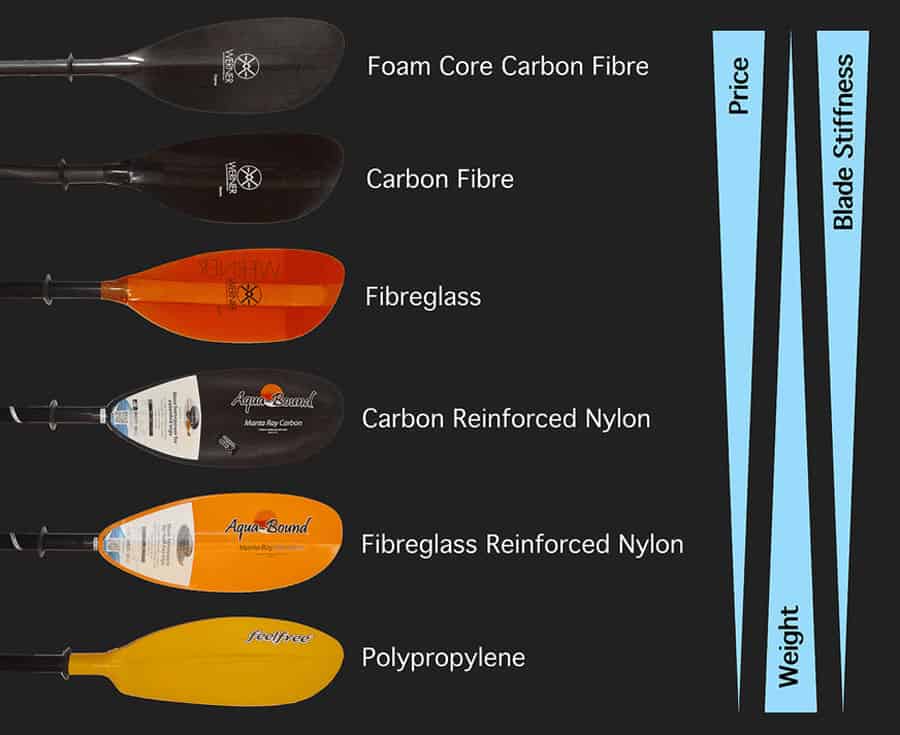
If you want to save weight and raise performance, your paddle will cost more. Professional kayakers will lean toward the more expensive models, while recreational ones will be perfectly fine with the lower prices paddles.
Shaft materials
Plastic is not used often as the main material for a shaft, because it would bend under the force of each stroke in the water.
Aluminum shafts are common in the lower end of the price range. They are durable and serviceable. Just remember to leave them in the shade, otherwise they will get burning hot under direct sunlight.
Shafts can also be made out of carbon and fiberglass, just like the paddle. As you already know, these materials are strong and lightweight, but come at a price point that reflects their increased performance.
The Shaft
The shaft of the paddle is another variable in the equation of choosing a kayak paddle.
Shaft shape and diameter
There are 2 shaft shapes you can choose from:
- Straight shafts allow for the most flexibility in maneuvering the kayak in various situations, meaning it is the preferred shape of advanced kayakers.
- Bent shafts position your hands at a more comfortable grip angle during the stroke. Your wrist will be more comfortable, and paddling feels lighter with bent shafts, because your joints are in a more natural position throughout the stroke. This allows for more leisurely paddling.
The shaft of the paddle comes in 2 diameters: normal and small-diameter. People with smaller hands and kids should use small-diameter paddles.
How do you know if you need them? Check whether you can touch your thumb and pointing finger together when you are gripping the shaft. If they do not touch when holding a normal diameter shaft, you need the small-diameter one.
2 vs 4 piece shaft. Which is better?
Both 2 and 4 piece shafts are rugged. The only difference between them is that you can break 4 piece shafts down into smaller parts.
4 piece shafts are useful if you go hiking with your kayak, or need the shaft to fit into a suitcase for example.
Shaft feathering
The blades of your paddle can be either feathered or matched. What does this mean?

As you can see above, matched blades are aligned with each other, while feathered blades are on a different plane.
What is the advantage of feathering your paddle blades? It reduces wind resistance on the blade that is out of the water during each stroke. It takes a bit of getting used to though.
Pretty much every paddle shaft nowadays has feathering adjustment built into the shaft. Usually, you can set it to a given angle in 15° increments, but some shafts let you set whatever angle you choose.
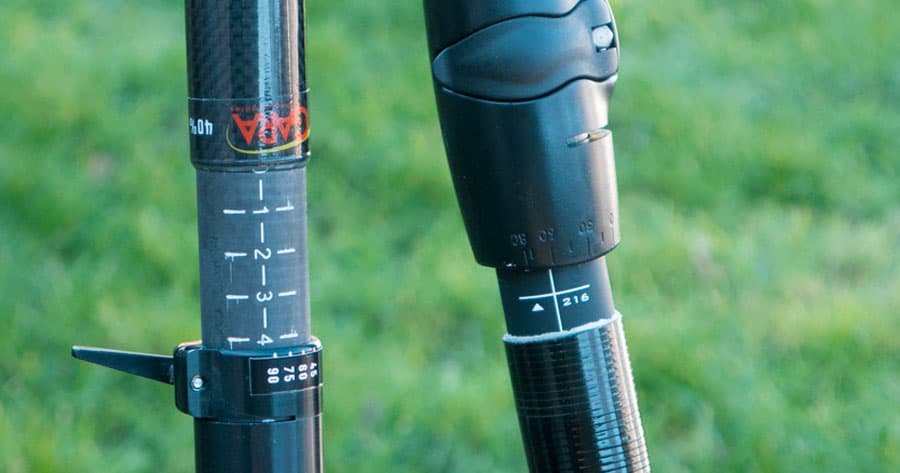
Choosing Your Inflatable Kayak Paddle
With all the aforementioned things, it could be quite tricky to choose a paddle, particularly if you have not used one before. If you are not sure, it’s safe to keep the paddle length within the 220 to 240cm range.
A 230 cm paddle usually works best for most people.
It should most likely work for you too. If you have paddled before, you should already know what your paddling style is. Regardless, make sure you adhere to the following.
Spend Less
If you are buying a kayak paddle for the first time, ensure you don’t spend too much since there is no certainty over what paddle length would work for you the best.
Your inflatable kayak might come bundled with a paddle. It’s recommended you use that paddle extensively to get a fair idea of your paddling style and paddle length preferences, before upgrading to a better one.
Do Not Discount Paddle Weight
Besides length, paddle weight matters too. The range is usually 1.5 to 3 lbs, and believe me, it really makes a difference. Especially on longer trips.
Generally, the more expensive paddles are lighter. The cheaper offerings tend to be on the heavier side. The weight difference may not seem significant right at the onset. However, once you start using the paddle, you would feel the weight a lot more. If you are coming from a lightweight paddle, heavier paddles would seem like extra work.
Best inflatable kayak paddles for beginners
I have experimented with a lot of paddles, but I think the value of this paddle is great. It is made out of materials that usually make the paddle cost $200, but this one is much cheaper.
It is just the right length for most inflatable kayaks, but it might be a little long for narrow hard shell kayaks. As you already know from my article comparing inflatable and hard-shell kayaks, inflatable kayak paddles are usually longer than paddles for hard-shell kayaks, since inflatables have a wider base.
If you want to go for something cheaper, this one below is a good choice as well. It is pretty firm for the price, doesn’t have much flex at all. Very good value for recreational kayaking.
Werner also makes great paddles, but even their low-cost models cost more.
Conclusion
Choosing a paddle for your inflatable kayak is less about the kayak itself and more about the waters you’ll tread and your overall kayaking style. If you have good clarity about your kayaking skills and the level of kayaking you foresee yourself indulging in, you should not have much trouble choosing the right inflatable kayak paddle for yourself.

